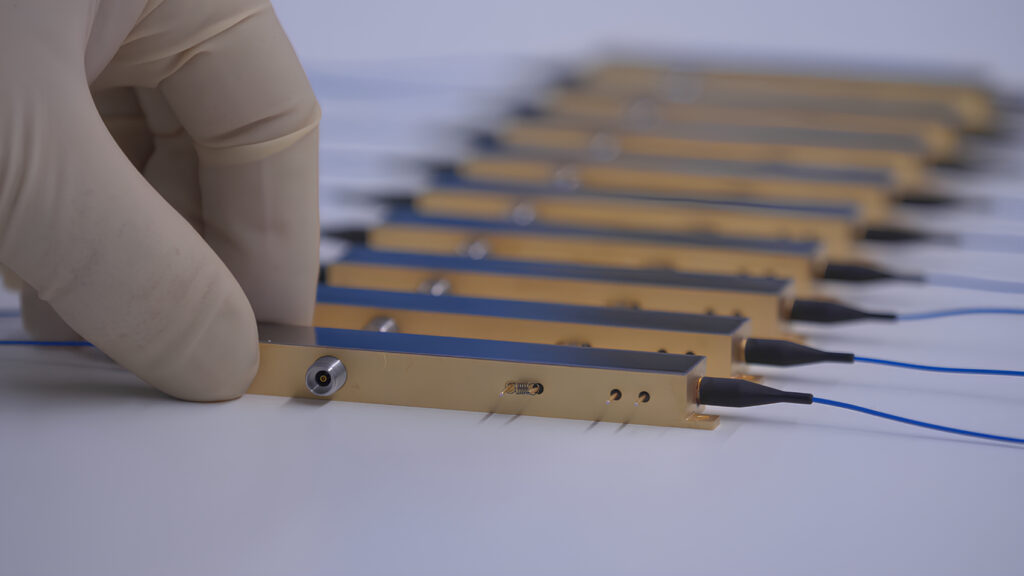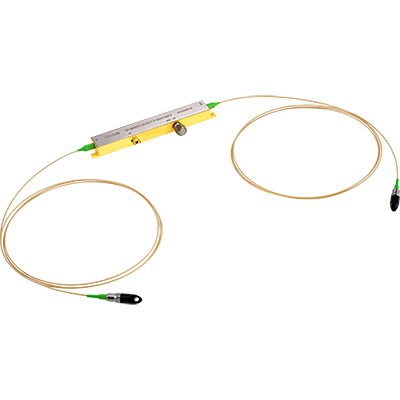- Photonics & Space
Optical modulators: en route for the New Space
Exail is a designer and a manufacturer of space grade optical components. The company especially masters the manufacturing of optical LiNbO3 modulators dedicated to space applications, with a track-record of successful missions embarking its “flight proven” components. Their robustness and reliability even under extreme conditions are appreciated. They are at the core of state-of-the-art technologies in development at Exail for the space domain: optical transceivers for space communications (in space and between space and ground stations), but also QKD systems that could one day fly on-board telecommunication satellites.

Hundreds of Exail LiNbO3 modulators already delivered for space missions
The LiNbO3 modulators offer a unique combination of performance that makes them prime candidates to satisfy the optical system specifications, and to meet the tough requirements of space operations. Today, many embarked space photonic systems use such modulators as key components to achieve intensity or phase modulation. Many space projects already involve Exail’s TRL9 modulators, for a total of more than 300 units delivered. They are amplitude and phase LiNbO3 modulators in the 850nm, 1064nm and 1550nm ranges, offering several options such as high extinction ratio or low Vπ. They are deployed either onto the Geostationary Earth Orbit (GEO), or onto the MEO (Medium Earth Orbit) and LEO (Low Earth Orbit) satellites. The GEO imposes the most stringent operating conditions as systems have to operate during at least 20 years (average GEO satellites life expectancy) and have to sustain extreme temperature variations (they can sustain temperatures from -40°C to 85°C, and operate at full performances between 0°C and 70°C). The instruments and components are also exposed to strong vibrations and shocks during the spacecraft take-off and while flying through the atmosphere in the satellite deployment phase, the space vacuum and the dangerous solar radiation.
The reliability of Exail modulation solutions in space environment, especially in GEO orbit, comes from the company core business which is the development of Inertial Navigation Systems (INS) based on Fiber-Optic Gyroscopes (FOG). The FOG principle is a patented technology, based on an optical fiber coil. The coil diameter & length determine the rotation precision. A phase modulation solution developed by Exail is used to bias the system. The technology allows to get very close to theoretical performances, reaching the high requirements in difficult environment from subsea to space, for instance. For over 20 years, Exail has been partnering with Airbus Defence & Space for the delivery of its FOG system “Astrix”, to equip more than 30 satellites, counting more than 6 million hours in orbit (in GEO) without incident.

Exail flagship LiNbO3 modulators now available in Engineering Model, New Space Flight Model and Flight Model
The NIR-MPX-LN-0.1 is an electro-optical phase modulator featuring a wide bandwidth from DC to more than 300 MHz. Like all Exail Near InfraRed (NIR) modulators, it uses a proton exchanged based waveguide process that confers them an unparalleled stability even when operating at high optical power and over a wide range of temperatures. The NIR-MPX-LN-0.1 phase modulator comes with high Polarization Extinction Ratio (PER) and Low Insertion Losses (LIL). Its main features are (on top of being qualified for harsh environments), its optical power up to 20 dBm, its high impedance, its low insertion losses and its low Vπ.
The NIR-MPX-LN-0.1 phase modulator exists in a Terrestrial Grade version perfectly suited for laser applications such as Directed Energy Laser applications, with the Beam Combining Technique. A TRL9 version of the NIR-MPX-LN-0.1 phase modulator has already been used in successful space missions such as the NASA Mission “Grace Follow On” since 2018.
Leveraging this extensive experience, Exail is now offering the space-grade “NIR-MPX-LN-0.1” under three different versions according to customer’s requirements in terms of qualification. The product having already been submitted to a thorough qualification and having been embedded into satellites (TRL9), the COTS NIR-MPX-LN-0.1 product line is now offered to answer the current needs of the space industry, with the rise of New Space.
The standardized versions of Exail’s space-grade phase modulators are cost-effective solutions with different levels of customizations possible according to each customer requirements:
- The Engineering Model (EM) version is flight representative in form, fit and function. It is manufactured exactly like a TRL9 modulator, but no batch unicity nor space compacity checks are performed during the assembly process, neither any further screening nor space qualification tests, as long as specifications of the products are met in terms of performance. This EM NIR-MPX-LN-0.1 is the ideal cost-effective version for a customer willing to test the performance of a TRL9 component for a given space system design, when working on the final validation. They are used for functional qualifications, except redundancy verification, failure survival demonstration and parameter drift checking.
- The New Space Flight Model (NS-FM) version is a flying version based on its qualification heritage (available on request), which is ideal for New Space low costs developments. This already-flight proven product is designed and manufactured like a flight hardware and is sampled after screening test to eliminate items whose behavior doesn’t meet the specifications during temperature tests. Such a NS-FM NIR-MPX-LN-0.1 is thus relying on qualifications performed for previous TRL9 components that successfully flew in space, following the same manufacturing and assembling process, and including some basic screening tests.
- The high reliability Flight Model (FM) is the flying version based on legacy space standards: these modulators are assembled from a unique batch and are submitted to acceptance-level testing (Lot Acceptance Tests corresponding to a relaxed qualification tests program) after preliminary selection by temperature screening tests. Such a FM NIR-PMX-LN-0.1 is delivered with its full documentation and test reports, ensuring to the customer that the modulators are flight-proven.
“If the New Space Flight Model (NS-FM) modulators are flying versions based on qualification heritage, the high reliability Flight Model (FM) modulators are coming from the same batch of fabrication and are following a dedicated relaxed qualification program (or lot acceptance test). This qualification program can be discussed with the customer depending on mission specifications. Some components from the same batch will be selected for a more drastic qualification program to validate the entire batch. The most drastic qualification program is described in Reliability assurance guideline for lithium niobate-based electro-optical modulators (available on demand). However, based on Exail heritage & background, the number of components for qualification can be reduced, and the qualification program simplified.” Explains Clement Guyot – Space product line manager at Exail.
Towards a broader offer of space-grade COTS optical components
The radiation hardened (rad-hard) fibers and their matching Fiber Bragg Gratings (FBGs), the fiber sources, the low noise optical amplifiers, the Multiplexer/Demultiplexer and other micro-optics assemblies are other space-grade components and sub-components offered by Exail. For example, the optical transceiver developed by the company, in close collaboration with Airbus (its demonstration model TELEO is flying onboard the telecommunication satellite Arabsat BADR-8 launched in May 2023) is made of a compact Optical Channel Emitter (OCE) integrating a LiNbO3 modulator and a RF amplifier designed by Exail. Several OCEs can be multiplexed by a Mux produced in-house with the expertise in manufacturing robust micro-optics assemblies. And the reception channel integrates a proprietary LNOA (Low Noise Optical Amplifier) designed and assembled by Exail.
All those components will soon be available in dedicated COTS product lines, starting with the RF amplifier designed for the transceiver OCE. And among the LiNbO3 phase and intensity modulators, the next reference that will be available in space-grade COTS are the NIR-MPZ-LN-20, a phase modulator adapted to high frequency thanks to its low Vπ, and the MXER-LN-10, an intensity modulator in 1500nm with high contract (more than 30dB).


